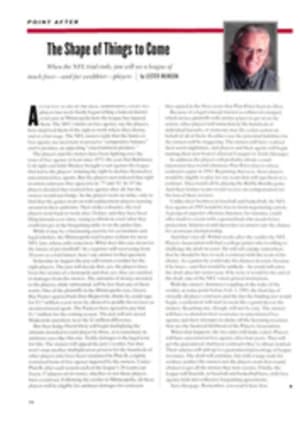
The Shape of Things to Come
After five years of Pretrial Skirmishing, eight NFL players last week finally began telling a federal district court jury in Minneapolis how the league has injured them. The NFL's limits on free agency, say the players, have deprived them of the right to work where they choose and at a fair wage. The NFL owners reply that the limits on free agency are necessary to preserve "competitive balance" and to produce an appealing "entertainment product."
The players and the owners have been fighting over the issue of free agency at least since 1972, the year that Baltimore Colt tight end John Mackey brought a suit against the league that led to the players' winning the right to declare themselves unrestricted free agents. But the players surrendered that right in union contracts they agreed to in '77 and '82. In '87 the players decided they wanted free agency after all, but the owners would not budge. So the players went on strike, only to find that the games went on with replacement players running around in their uniforms. Their strike a disaster, the real players went back to work after 24 days, and they have been filing lawsuits ever since, trying to obtain in court what they could not get at the bargaining table or on the picket line.
While it may be a fascinating exercise for economists and legal scholars, the Minneapolis trial is pure tedium for most NFL fans, whose only concern is: What docs this case mean for the future of pro football? As a reporter still recovering from 20 years as a trial lawyer, here's my answer to that question.
Sometime in August the jury will return a verdict for the eight players. The jury will decide that, yes, the players have been the victims of a monopoly and that, yes, they arc entitled to damages from the owners. The amounts of money awarded to the players, while substantial, will be less than any of them wants. One of the plaintiffs in the Minneapolis case, Green Bay Packer quarterback Don Majkowski, thinks he could sign for $3.7 million a year were he allowed to peddle his services as an unrestricted agent. The Packers have agreed to pay him $1.7 million for the coming season. The jury will not award Majkowski anywhere near the $2 million difference.
But then Judge David Doty will begin multiplying the amount awarded to each player by three, as is customary in antitrust cases like this one. Treble damages is the legal term for this. The owners will appeal the jury's verdict, but that won't stop another multiplication process for the hundreds of other players who have been victimized by Plan B, a tightly restricted form of free agency imposed by the owners. Under Plan B, after each season each of the league's 28 teams can freeze 37 players on its roster, whether or not those players have a contract. Following the verdict in Minneapolis, all these players will be eligible for antitrust damages for contracts they signed in the three years that Plan B has been in effect.
Because of a legal concept known as collateral estoppel, which invites plaintiffs with similar gripes to get in on the action, other players will immediately file hundreds of individual lawsuits, or someone may file a class action on behalf of all of them. In cither case the potential liabilities for the owners will be staggering. The owners will have realized their worst nightmare, and players and their agents will begin naming their new boats Collateral Estoppel or Treble Damages.
In addition the players will probably obtain a court injunction that would eliminate Plan B for players whose contracts expire in 1993. Beginning that year, those players would be eligible to play for any team that will sign them to a contract. They would all be playing the Bobby Bonilla game. And their former teams would receive no compensation for the loss of their services.
Unlike their brethren in baseball and basketball, the NFL free agents of 1993 would be free to form negotiating cartels. A group of superior offensive linemen, for instance, could offer itself to a team with a quarterback who needs better protection. Salaries would skyrocket as owners saw the chance for an instant championship.
And that's not all. Within weeks after the verdict the NFL Players Association will find a college junior who is willing to challenge the draft in court. He will tell a judge somewhere that he should be free to seek a contract with the team of his choice. As a junior he could take his chances in court, because if he loses—and that would be unlikely—he could still enter the draft after his senior year. If he won, it would be the end of the draft, one of the NFL's most prized institutions.
With the owners' dominoes toppling in the wake of the verdict, at some point before Feb. 1, 1993, the final day of virtually all player contracts and the day the bidding war would begin, a settlement will start to seem like a good idea to the owners. Reaching one, though, will not be easy. The owners will have to abandon their resistance to unrestricted free agency and their attempts to choke off the licensing revenues that are the financial lifeblood of the Players Association.
When that happens, the two sides will make a deal. Players will have unrestricted free agency after four years. They will get the guaranteed, multiyear contracts they've always wanted. Their salaries will add up to a guaranteed percentage of league revenues. The draft will continue, but with a wage scale for rookies; neither the owners nor the players want first-round choices to get all the money they now receive. Finally, the league will flourish, as baseball and basketball have, with free agency built into collective bargaining agreements.
Save this page. Remember, you read it here first.
PHOTO
KEVIN HORAN

